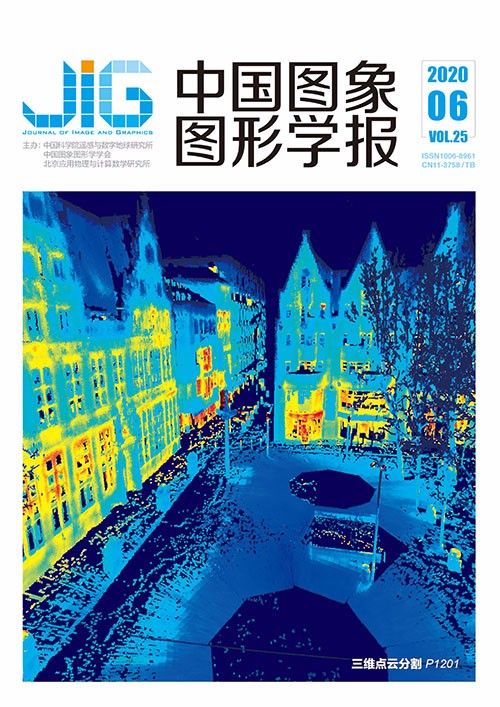
字典神经网络方法快速湍流烟雾合成
柏凯1,2,3, 李伟1,2,3, 刘晓培1,2,3(1.上海科技大学信息科学与技术学院, 上海 201210;2.中国科学院大学, 北京 100049;3.中国科学院上海微系统与信息技术研究所, 上海 200050) 摘 要
目的 基于物理的烟雾模拟是计算机图形学的重要组成部分,渲染具有细小结构的高分辨率烟雾,需要大量的计算资源和高精度的数值求解方法。针对目前高精度湍流烟雾模拟速度慢,仿真困难的现状,提出了基于字典神经网络的方法,能够快速合成湍流烟雾,使得合成的结果增加细节的同时,保持高分辨率烟雾结果的重要结构信息。方法 使用高精度的数值仿真求解方法获得高分辨率和低分辨率的湍流烟雾数据,通过采集速度场局部块及相应的空间位置信息和时间特征生成数据集, 设计字典神经网络的网络架构,训练烟雾高频成分字典预测器,在GPU(graphic processing unit)上实现并行化,快速合成高分辨率的湍流烟雾结果。结果 实验表明,基于字典神经网络的方法能够在非常低分辨率的烟雾数据下合成空间和时间上连续的高分辨率湍流烟雾结果,效率比通过在GPU平台上直接仿真得到高分辨率湍流烟雾的结果快了一个数量级,且合成的烟雾结果与数值仿真方法得到的高分辨率湍流烟雾结果足够接近。结论 本文方法解决了烟雾的上采样问题,能够从非常低分辨率的烟雾仿真结果,通过设计基于字典神经网络结构以及特征描述符编码烟雾速度场的局部和全局信息,快速合成高分辨率湍流烟雾结果,且保持高精度烟雾的细节,与数值仿真方法的对比表明了本文方法的有效性。
关键词
Fast turbulent smoke synthesis via a dictionary-based neural network
Bai Kai1,2,3, Li Wei1,2,3, Liu Xiaopei1,2,3(1.School of Information Science and Technology, ShanghaiTech University, Shanghai 201210, China;2.University of Chinese Academy of Sciences, Beijing 100049, China;3.Chinese Academy of Sciences, Shanghai Institute of Microsyst and Information Technology, Shanghai 200050, China) Abstract
Objective Physics-based smoke simulation is an important topic in computer graphics. Realistically simulating turbulent smoke flows is generally computationally expensive due to intrinsic small-scale structures that require sophisticated nondissipative solvers with a relatively high resolution. To effectively preserve small-scale structures, neural networks have been recently proposed and applied. However, the common problem in previous models for upsampling fluid flow fields with added small-scale structures is that the upsampled fluid field may not be sufficiently close to the corresponding high-resolution simulations. This problem may produce visual artifacts as important features, e.g., vortex rings that require high-resolution samples to capture can be overlooked. The difficulty behind such upsampling, which considerably differs from image upsampling, is that the flow structures between high- and low-resolution simulations can substantially differ. This structure inconsistency becomes increasingly evident when high and low resolutions differ significantly from local nonlinear vortex structures to the global shape of turbulent flow distributions. To enable upsampling with close similarity to its high-resolution simulation counterpart, local and global information should be acquired and encoded. In this study, we propose a novel dictionary-based neural network for synthesizing the high-frequency components of a turbulent smoke flow from a very low-resolution simulation. By learning a local generative scheme from a large set of patches that exist in high-resolution simulations, our network can faithfully synthesize a high-resolution smoke flow that closely resembles the corresponding high-resolution simulations, with well-preserved important features and considerably improved computing efficiency. Method First, high- and low-resolution turbulent smoke data are simulated using a high-precision numerical method. We propose a feature vector that encodes the local velocity information of each 3D patch, global position, and time. This vector can help accurately predict local high-frequency components. Then, we construct a novel neural network based on the dictionary learning framework; this network simultaneously learns the dictionary and the associated coefficients. High-resolution smoke data have more details than low-resolution smoke data; thus, the former has a more complex spatial structure. Accordingly, we add gradient loss to maintain the spatial structure, with a regularization term to prevent overfitting. The advantage of our model is that it jointly optimizes all the layer parameters from end to end. After the training process, our neural network can learn a complex mapping function to efficiently synthesize high-resolution turbulent smoke patch data. During online synthesis given a low-resolution simulation, the trained neural network is used to predict overlapping local patches in parallel, with convolution in overlapping regions to ensure smooth transition. Result On the basis of the experimental results, we propose a novel dictionary-based neural network as a small-scale structure predictor to address such upsampling problem. The proposed neural network can produce spatially and temporally consistent high-resolution flow fields from very low-resolution simulations that closely approximate the direct high-resolution simulation results, with considerably improved computational efficiency. Our method faithfully preserves small-scale structures by comparing low- and high-resolution simulations. With our learning-based fast smoke simulation method, efficiency is improved by one order of magnitude compared with direct simulations at a resolution of 200×400×200 with highly similar results. Conclusion In this study, we address the crucial problem of synthesizing a high-resolution flow field from a very low-resolution simulation to achieve efficient smoke animation. The synthesized high-resolution flows can closely approximate their simulation counterparts. To produce a high-resolution flow field, we design a novel neural network that is motivated by dictionary learning and a new feature descriptor that encodes local and global information. The neural network can be used for efficient synthesis to quickly predict flow details in high resolutions. Parallel implementations of such mechanisms are realized on a GPU, with comparisons with numerical simulations to highlight the advantages of our method.
Keywords
|



 中国图象图形学报 │ 京ICP备05080539号-4 │ 本系统由
中国图象图形学报 │ 京ICP备05080539号-4 │ 本系统由